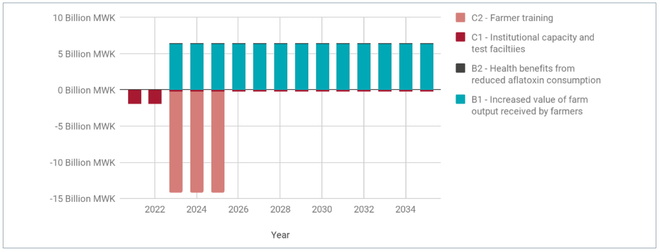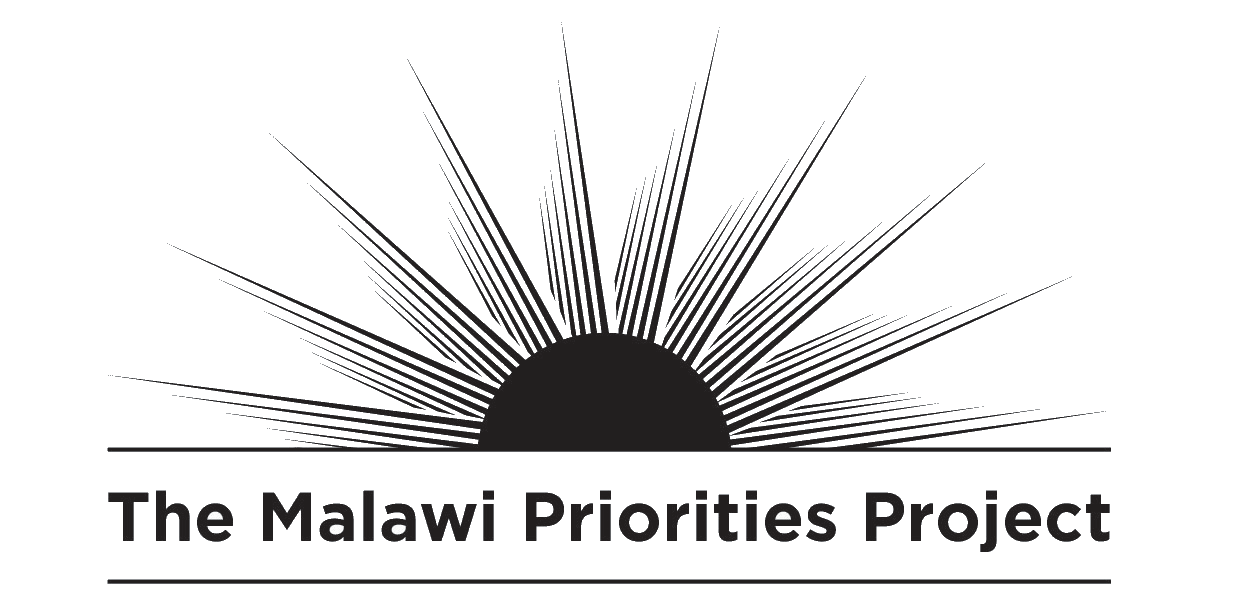Malawi Priorities: Agriculture: Exports
Technical Report
Key Messages
- Although the majority of Malawi’s economy depends on agriculture, there are limited crops that are currently suitable for export to neighboring countries.
- Two barriers preventing the export of regionally demanded crops are the long-standing export ban on maize and poor quality-control standards and regulations for groundnuts.
- Removing the maize export ban would create wealth worth about 1% of GDP per year. While maize prices would increase for consumers, and mostly impact those who only consume and do not produce maize, the net benefits from exports and increased production value for farmers are so large that winners could compensate losers, via taxation and redistribution, with all members of society better off.
- Teaching farmers how to produce more premium grade groundnuts for export, improving the Malawi Bureau of Standards, and building a test facility would increase farmer income from groundnuts by MKW 6.3 billion annually (0.1% of GDP). The initial cost associated with training, institutional capacity to export premium groundnuts, and reduce aflatoxin contamination could be as high as MKW 45.7 billion (assuming US$75 per farmer), however, the result is a net wealth creation even under moderate groundnut export assumptions.
Context
Agriculture is the backbone of Malawi’s economy; it accounts for almost 80 percent of employment, and 80 percent of the country’s total exports (World Bank, 2020). However, Malawi remains highly reliant on tobacco and has been slow to diversify into other crops.
As Malawi is shifting its dependence on tobacco as a major foreign currency earner for the economy, it is imperative to look into policy solutions for other traditional cash crops. Improved production and commercialization of other crops would help to attain the main objective of Vision 2063 of generating inclusive wealth for all in Malawi. Thus one important question in Malawi Priorities’ research agenda is “Which high-value crops are suitable to be grown in Malawi and are demanded by countries with relatively low-cost transport links?”
Some of the key barriers that have limited Malawi’s ability to export high-value crops include ad hoc export bans on key commodities and/or lack of coherent policy framework, low quality of agricultural products (including aflatoxin contamination), low farm productivity, insufficient processing capacity in-country, high storage, processing and transportation costs, poorly coordinated supply chains to address problems of aggregation, quality, and safety and consistency of supply.
Intervention 1: Remove the export ban on maize and create an MKW 538 billion surplus for farmers per year, where MKW 61 billion per year is net wealth creation
The social and economic benefits of removing the export ban on maize outweigh the costs by 13%. The benefit-cost ratio (BCR) is 1.13, a small ratio, but since maize is the backbone of the agricultural economy the economic benefits for maize producers sum up to over MKW 538 billion per year. The economic benefits are created by an increase of maize prices to the levels of neighboring countries and an increase in production in response to the higher prices.
Although maize prices increase significantly for consumers, about 60% of consumers are also producers, so this group would likely have positive net welfare outcomes. The loss for the consumers is only 89% of the gain for producers. Specific groups, for example, landless and urban poor could be compensated in more efficient ways than an export ban.
The link between wealth creation and maize price fluctuations
International maize prices are subject to fluctuations which can impact the results of the intervention. The base assumption is an average price of 0.4 USD/KG. A 25% higher price would increase the BCR to 1.3 and generate a wealth of MWK 290 billion per year. A lower price lower than (less than 0.3USD/KG) would result in no exports due to transportation costs.
Domestic prices in Malawi have, and will continue to fluctuate. The average price in Malawi over the past 10 years was 0.24 USD/ KG, with a standard deviation of 0.07. The more deviation between local and international prices (in this case associated with lower prices domestically) the greater the BCR and associated wealth creation. This is again because the producer surplus and consumer surplus are more affected by greater changes in prices.
The consumers’ and producers’ responses to price fluctuations will also impact the magnitude of wealth creation. However major shifts are unlikely for a staple grain such as maize.
These issues affect several different agricultural supply chains, including maize, soya beans, groundnuts, and timber. Other supply chains, such as tobacco, tea, sugar, and coffee are better established and more organized, though they also face unique barriers, such as low productivity and declining export prices. The following policy solutions for maize and groundnuts demonstrate the greatest potential for export growth and alignment with national priorities.
Figure 1
[[{"fid":"5774","view_mode":"teaser","fields":{"format":"teaser","field_file_image_alt_text[und][0][value]":false,"field_file_image_title_text[und][0][value]":false},"link_text":null,"type":"media","field_deltas":{"3":{"format":"teaser","field_file_image_alt_text[und][0][value]":false,"field_file_image_title_text[und][0][value]":false}},"attributes":{"class":"media-element file-teaser","data-delta":"3"}}]]
Figure 2

Intervention 2: Teach farmers how to store and grade groundnuts, improve the Malawi Bureau of Standards, and build a test facility to increase farmer income by MKW 6.3 billion annually
Groundnuts are an important crop in Malawi, but for smallholder farmers to be able to compete in international markets, quality certification is necessary. Grading and separating the premium grade groundnuts for sale in larger formal markets (ESA and EU) would increase the value of farm output.
The presence of poisonous aflatoxin produced by certain molds when crops are improperly stored is another crucial factor that not only prohibits exports but also has negative health effects.
Testing facilities and farmer training would reduce the aflatoxin contamination in groundnuts sold in domestic markets too, reducing exposure and consumption of contaminated groundnuts. The improved health as a result of the intervention translates to avoiding 10.8 deaths per year (MKW 0.19 billion per year).
The main cost involved in training farmers using a high-end estimate of US$75 per farmer, adding up to MKW 42 billion for 750,000 farmers over 3 years. A start-up cost of MKW 3.7 billion is associated with improving the policy, test facilities, and accreditation process of the Malawi Bureau of Standards (MBS), as well as developing the capacity of MBS staff. The annual cost of a test laboratory is MKW 0.3 billion.
The cost associated with training and institutional capacity to export premium groundnuts and reduce aflatoxin contamination
Farmer education on using pre and post-harvest techniques to reduce aflatoxin contamination is important for grading improvements. Outreach and training are also crucial in order for the farmers to access profitable markets. The costs for agricultural extension activities are estimated using a study by Ksoll et al. (2016), which factors the use of trained staff rather than village agents making it an appropriate conservative estimate.
Currently, the MBS does not provide testing services. The intervention would aim to establish a testing laboratory that can verify the aflatoxin contamination levels in common crops, such as maize and groundnuts, as well as assist the MBS to develop policies in line with the National Quality Policy and develop an accreditation process.
The costs for improving the institutional capacity of MBS are based on the Standardization, Quality Assurance, Accreditation, Metrology Project (SQUAM), funded by the EU. The project includes interventions aimed at improving the MBS policy framework and capacity, for verifying grading standards, thereby providing a reasonable cost estimate. Also included are the annual cost estimations operations and maintenance of the lab,a consultant to review and update the policy framework and regulations for MBS.
The link between wealth creation and proportion of premium quality groundnuts
The proportion of groundnuts that qualify as premiums is the main driver of both benefits examined in the analysis. Based on the experience of the Mchinji Area Smallholder Farmers Association, which currently sells premium groundnuts through a fair trade agreement to the EU, the premium proportion is 9%. The assumption is that the proportion of groundnuts that qualify as premium would increase over time as more farmers are trained in proper pre and post-harvest methods. This would lead to increased profits for premium-grade products. At 15% premium quality the farmer income increases by MWK 10.5 billion per year. If only 5% qualify as premium, then the farmer income increase is only MWK 3.5 billion per year, and the BCR is 0.7 representing a poor investment where the costs of this intervention far outweigh the benefits. Besides, an increased quality groundnut production could lead to agro-processing opportunities for Malawi in the groundnut value chain.
It is important to note that the analysis conducted here is based on conservative assumptions about the scale of the sector. In both CBAs, it is assumed that the level of production will remain the same. However, it is reasonable to assume that the stability of policies and the opportunity to sell groundnuts at premium prices can increase investor confidence for expanding the production of maize and groundnuts. It can also be argued that more farmers would aim to improve their post-harvest handling techniques once they realize the potential for increased revenue from reducing the levels of aflatoxin.
Summary Table
| Intervention | BCR | Beneficiary Group | Investment cost | Benefits |
|---|---|---|---|---|
| Training and institutions for groundnut quality control | 1.2 Fair (97% economic benefits) | 750,000 farmers, and consumers of groundnuts | MKW 42 billion for training, MKW 3.7 billion for building institutional capacity, MKW 0.3 annual operations |
MKW 6.3 billion annual wealth creation from increased groundnut value and exports. 10.8 deaths avoided per year from reduced aflatoxin |
| Remove export ban on maize | 1.1 Fair (100% economic benefits) | Farmers producing maize | Political cost, and the cost of a scheme to redistribute between winners and losers of resulting maize price increases | MKW 61 billion annual wealth creation from maize exports |
Note: BCRs are based on costs and benefits discounted at 8% (see accompanying technical report). BCR ratings are determined on the following scale Excellent, BCR > 15; Good, BCR 5-15; Fair, BCR 1-5; Poor, BCR < 1. This traffic light scale was developed by an Eminent Panel including several Nobel Laureate economists for a previous Copenhagen Consensus project that assessed the Sustainable Development Goals.
Download the full policy brief here.

